Newcastle managed to beat the better performers Sheffield United, thanks to their solid defensive actions and the perfect timing of their attacking ones. Despite Sheffield United’s dominance while having only 27% of the possession, the Newcastle players were able to take advantage of their opponent’s mistakes, while making sure to not allow lapses in their own defence.
The lack of strong finishing by Sheff United’s front duo helped them too, although they conceded a few chances and the only reason for them keeping the clean sheet is the outstanding performance by the keeper Martin Dúbravka.
The Magpies worked strongly under pressure, and despite lacking the perfect build-up and structure, they managed to make things work timing their attacks well.
This tactical analysis aims to break-down both team’s tactics using analysis and answer why Sheffield United failed in their efforts to score, despite controlling the game.
Lineups
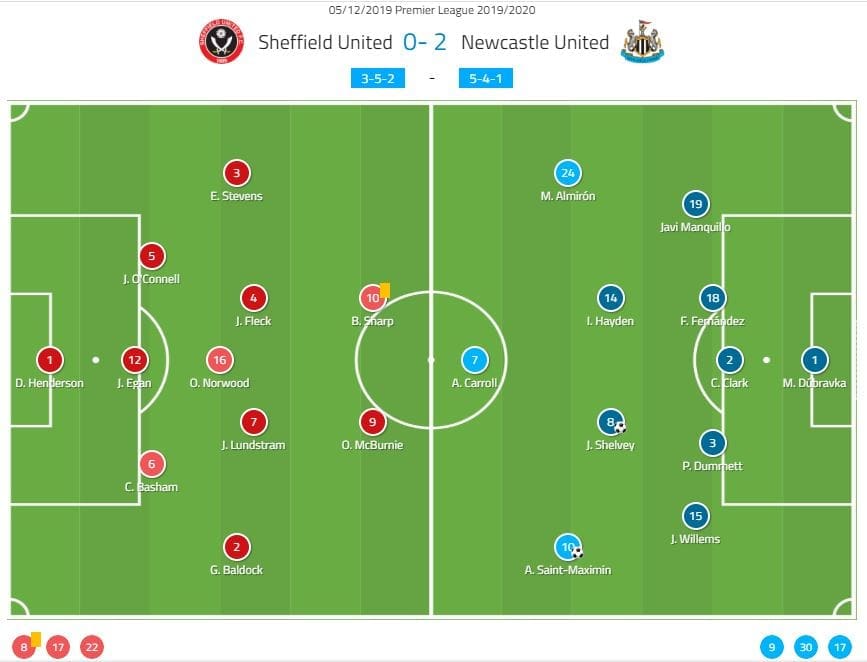
Chris Wilder opted for a 3-5-2 formation, starting off with Dean Henderson on the goal. His back-three contained Jack O’Connel, John Egan and Chris Basham. Enda Stevens and George Baldock were serving as the wing-backs, having John Fleck, Oliver Norwood and John Lundstram covering the middle. The front two included Billy Sharp and Oliver McBurnie.
Steve Bruce chose to focus on the teams’ defensive stability and lined them up in a 5-4-1 scheme. The best performer Martin Dúbravka covered the goal. When out of possession the defensive players were Jetro Willems, Paul Dummett, Ciaran Clark, Federico Fernández and Javier Manquillo. Jonjo Shelvey and Isaac Hayder were covering the centre areas, trying to deliver the ball to Andy Carroll who was chosen for a lone striker. The wings were covered by Allan Saint-Maximin and Miguel Almirón.
Newcastle’s defensive structure
Newcastle’s defensive performance impressed. The away team’s work under pressure and structure was solid, despite the opposition’s press. They had a clear defensive strategy, dropping five players in the back-line (5-4-1 formation out of possession), and that seems to be one of the reasons to work well under pressure and allow their opponents in their own half more often. Apart from their excellent positioning and covering depth, winning 57,14% of their aerial duels was also crucial. Taking advantage in that helped them in diverting Sheffield’s crosses and corners.
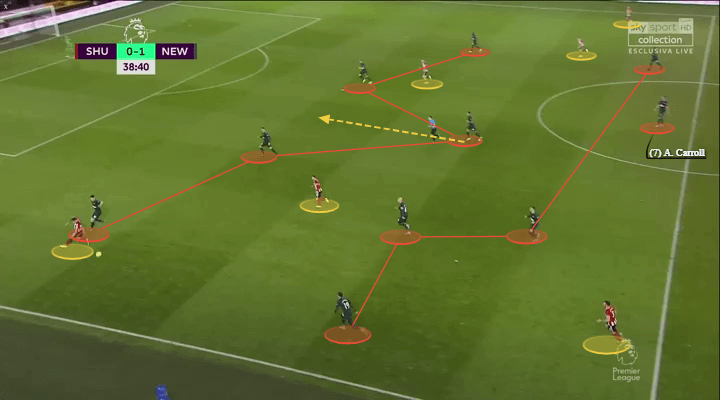
What pinned them back, though, was their struggle to keep the possession of the ball, as already mentioned, they were losing the ball too often, which led to their opponent’s taking control of the game and being able to attack dangerously. Their low-block though turned out effective and they managed to keep a clean sheet.
They would rarely allow being stretched out wide. Once they covered the opposition’s wingers, they made sure to drop and additional man to the backline to cover depth.
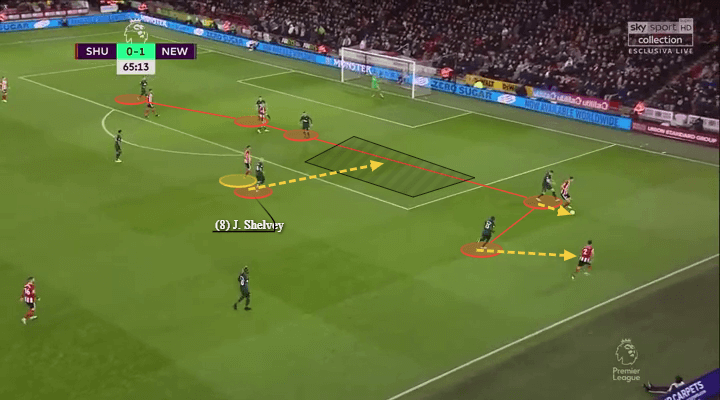
The keeper Dúbravka had a huge impact on their defensive record since he saved United’s all five shots on goal.
The Magpies’ right timing and patience
The team’s build-up strategy was uncertain. They often failed to bypass the press and couldn’t find the best way to distribute the ball to the more advanced areas. Sheff Utd were covering the passing lanes well, which didn’t allow Newcastle to circulate the ball in the way they have planned. They tried using both flanks to attack through, but what seemed like their best effort, were their long balls trying to find Andy Carroll on the tip of the attack. Dúbravka tried to contribute to the build-up, by sending long balls upfront, in order to escape the press and speed up their actions.
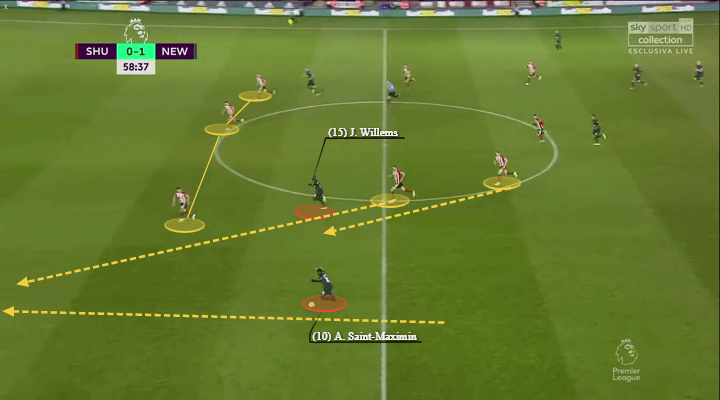
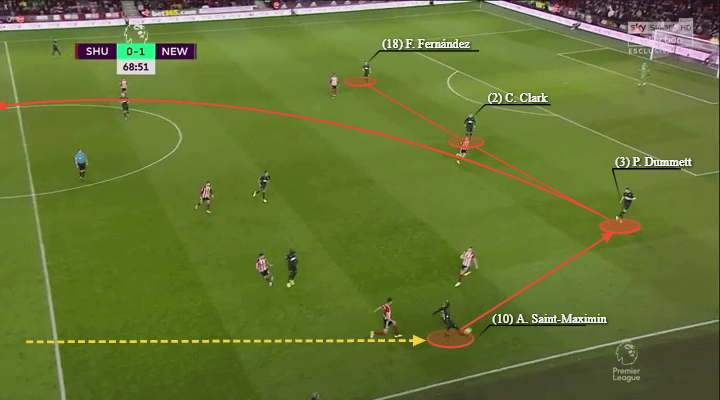
The low passing accuracy didn’t help them much in the pursuit of a goal-scoring opportunity. They did have their chances though, and it was due to them taking advantage of Sheff Utd’s mistakes and loss of concentration. Both of their goals are a result of their timing, as they patiently waited for their chances.
Newcastle focused their efforts into using their time on the ball to perform forward passes and find a way to shoot. In the times they weren’t able to break the opposition defence, they relied on long-distance shots. Jetro Willems was most frequently supporting the attacking movement by providing an additional passing option and doing rotations with his teammates.
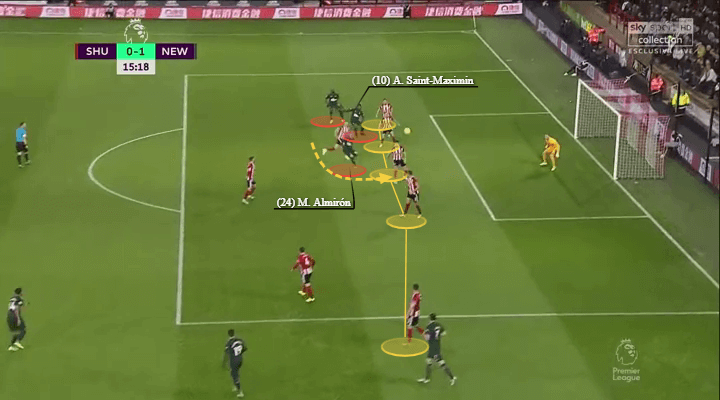
Sheffield United’s build-up and control
Sheffield United were allowed to control the game since the beginning. The team were calm on the ball and the lack of counter-press by the Newcastle players made their build-up even easier. It also allowed their defensive line to be highly positioned, limiting their opponents’ movement and contributing actively to the build-up. The centre-backs in their 3-5-2 formation were outsourcing the ball either to the central midfield or to the wing-backs, although the team most frequently used the left flank to build their attacks through.
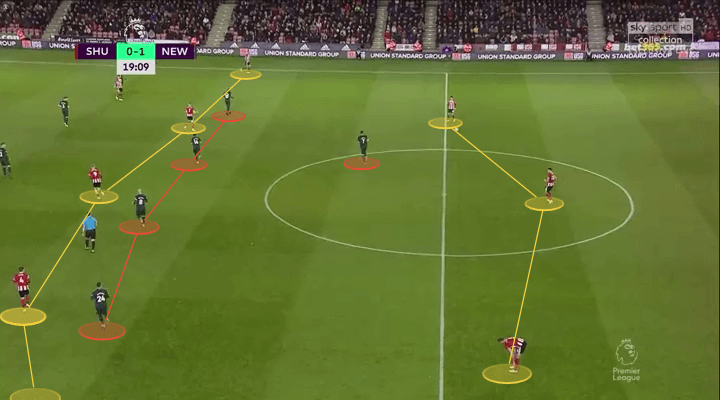
Newcastle rarely had time on the ball, which allowed Sheffield United to make the right decisions and use the passing lanes in the best possible way so they could deliver the ball further. The hosts created 46 positional attacks, meaning they were able to effortlessly build-up from the back and reach the final third.
Sheffield United were performing 6,18 passes on average per possession, which is proof of the lack of pressure from the opposition. They were able to retain possession for longer periods and they managed to convert that into goal-scoring opportunities on a few occasions. For comparison, the Magpies only managed to send 2,32 passes per possession on average.
The bigger amount of possession is not always a sign for better performance, but in Sheffield’s case, they were superior to Newcastle due to their high pass accuracy rate (86,01%). Most of the times the ball was reaching its destination, which helped the team in their attacking ventures and staying in control.
Not only Newcastle ended up with an extremely low amount of completed passes (232), but they often failed in providing a measured pass, which resulted in 71,12% passing accuracy. That’s one of the reasons the away team had fewer chances in front of the goal. They were struggling to distribute a good ball to the final third.
They would use their pace to counter too, trying to expose Newcastle during a transition, since they had to drop additional players in defence.
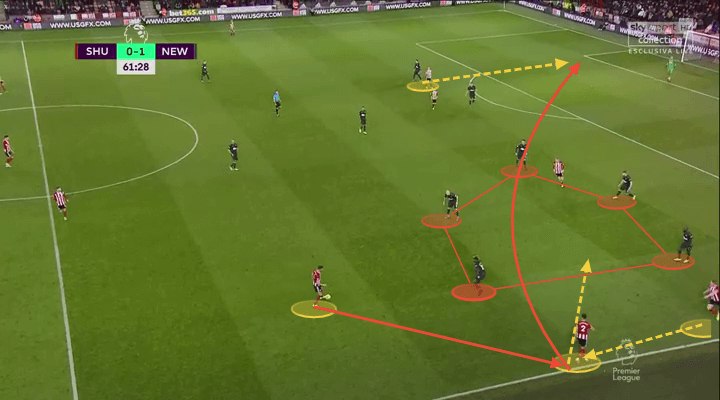
Oliver Norwood was the main passing link and covered wide areas in order to help with retaining possession and delivering the ball further. He sent 110 passes all over the pitch with 89% accuracy, which is proof of his importance for Sheffield United’s dominance. In the times he was trying to support the front line, his attacking actions and movement were extremely accurate.
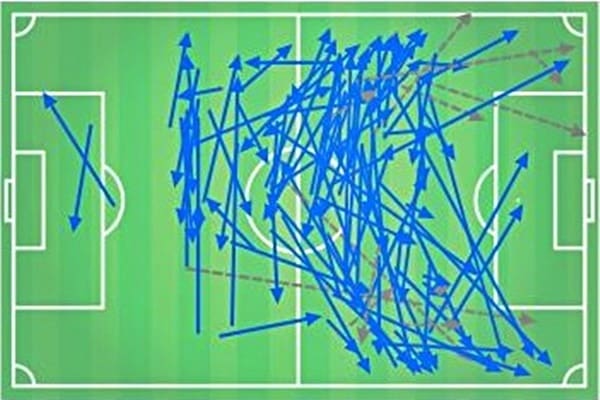
The Blades’ movement in the final third
Sheffield United were definitely the better performer when it comes to creativity and creating chances. But despite they performer 17 smart passes and were comfortably sitting in the opposition’s half, they failed to convert any of their 11 shots into goals. The lack of good finishing, combined with the amazing saves by Newcastle’s goalkeeper, kept them away from scoring, despite being the more active team and the one that didn’t experience trouble sending the ball to the final third.
The team were relying a lot on using the flanks. They managed to send 32 crosses, but Newcastle’s positioning and work under pressure seemed to be enough to block their efforts.
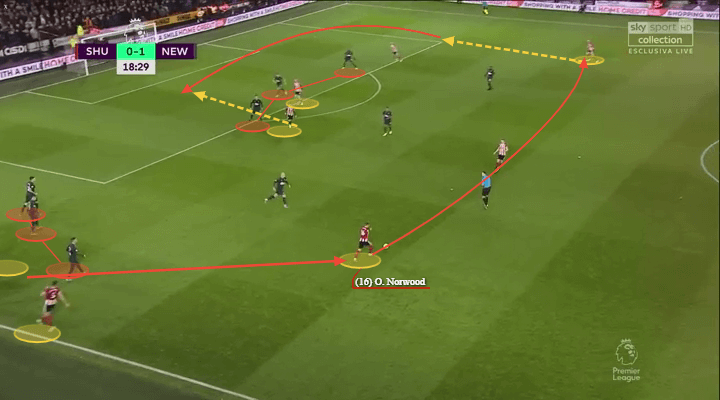
McBurnie was somehow isolated on the right and Sheffield relied only on Sharp’s efforts in front of the goal. His movement was good, but what was lacking is his timing, since he was always a split second late to receive the ball and shoot.
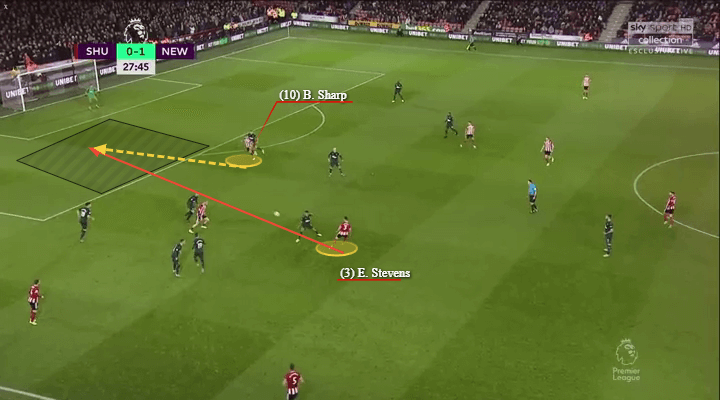
What played them a bad joke is their lack of offside awareness. They were caught offside three times, which resulted in wasting important chances.
Conclusion
Newcastle showed a defensive performance that should be duplicated in their upcoming fixtures if they want not only to reach but to remain in the top 10. Bruce needs to find a way to bypass the press and build a different build-up strategy when playing against dominant teams. Losing the possession too often is on the agenda for the team and they need to improve in their duels and control on the ball.
Sheffield United, on the other hand, are playing very entertaining football, matching the Premier League style and their strategy always seems well-executed. The lack of good finishing, though, is something they struggled with and as it happened was the reason for them missing on the three points in this game.

If you love tactical analysis, then you’ll love the digital magazines from totalfootballanalysis.com – a guaranteed 100+ pages of pure tactical analysis covering topics from the Premier League, Serie A, La Liga, Bundesliga and many, many more. Buy your copy of the December issue for just ₤4.99 here






Comments